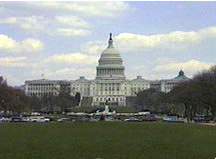Tue, Feb 22, 2011
Also Would Require Airlines To Specify Allowable Child Seat
Dimensions
 Among the amendments which were passed as part of the Senate
version of the FAA reauthorization bill was one written by Senators
Barbara Boxer (D-CA) and Olympia Snowe (R-ME) which would codify
the so-called "three hour rule" limiting tarmac delays for
airlines. The amendment would make permanent the "Airline
Passengers Bill of Rights," which was implemented by the Department
of Transportation last spring, as well as standardize rules dealing
with child protection seats allowed on airliners.
Among the amendments which were passed as part of the Senate
version of the FAA reauthorization bill was one written by Senators
Barbara Boxer (D-CA) and Olympia Snowe (R-ME) which would codify
the so-called "three hour rule" limiting tarmac delays for
airlines. The amendment would make permanent the "Airline
Passengers Bill of Rights," which was implemented by the Department
of Transportation last spring, as well as standardize rules dealing
with child protection seats allowed on airliners.
"The Senate's vote is a huge victory for job creation, for the
safety of air travel and for protecting the rights of airline
passengers nationwide," said Kate Hanni, Executive Director of
FlyersRights.org. "And the new Boxer-Snowe amendment for protecting
our most vulnerable infants in FAA approved CRS restraints, is a
giant step forward in protecting those who cannot advocate for
themselves. FlyersRights.org has been fighting for 4 years to
obtain permanent protections for airline passengers. We are
fortunate to have such fierce defenders of our rights to freedom
from being held hostage in an aircraft in Senator Boxer and Senator
Snowe."
The Department of Transportation began implementing parts of the
Boxer-Snowe Airline Passenger Bill of Rights last year, but the
bill passed by the Senate would codify those protections into law.
The protections include the so-called "three-hour rule,"
which requires airlines to give passengers the option of returning
to the terminal if they have been stuck on a plane for longer than
three hours.
The FAA bill also would require airlines to develop contingency
plans - approved by the Federal Aviation Administration - to ensure
that passengers are provided with adequate food, water and
restrooms, and allowed to deplane in the event of a lengthy tarmac
delay.

Kate Hanni
In addition, Senators Boxer and Snowe added an amendment to the
FAA bill which would require air carriers to post up front the
dimensions of a child safety seat that can be used on each aircraft
operated by the air carrier to enable passengers to determine which
child safety seats can be used on those aircraft.
The FAA Reauthorization Act will reportedly support 280,000 jobs
nationwide, according to the U.S. Travel Association, while helping
airports modernize their facilities and improve safety.
More News
Circle To Runway (Runway Number) Used by ATC to inform the pilot that he/she must circle to land because the runway in use is other than the runway aligned with the instrument appr>[...]
Aero Linx: National Aviation Safety Foundation (NASF) The National Aviation Safety Foundation is a support group whose objective is to enhance aviation safety through educational p>[...]
At Altitude Of About 250-300 Ft Agl, The Airplane Experienced A Total Loss Of Engine Power On November 6, 2024, at 1600 central standard time, a De Havilland DHC-1, N420TD, was inv>[...]
From 2009 (YouTube Edition): Three Hour Flight Was 'Flawless' -- At Least, Until Mother Nature Intervened For anyone who loves the aviation business, this was a VERY good day. Afte>[...]
Also: AMA Names Tyler Dobbs, More Falcon 9 Ops, Firefly Launch Unsuccessful, Autonomous F-16s The Air Force has begun ground testing a future uncrewed jet design in a milestone tow>[...]
 ANN's Daily Aero-Term (05.05.25): Circle To Runway (Runway Number)
ANN's Daily Aero-Term (05.05.25): Circle To Runway (Runway Number) ANN's Daily Aero-Linx (05.05.25)
ANN's Daily Aero-Linx (05.05.25) NTSB Prelim: De Havilland DHC-1
NTSB Prelim: De Havilland DHC-1 Classic Aero-TV: The Boeing Dreamliner -- Historic First Flight Coverage
Classic Aero-TV: The Boeing Dreamliner -- Historic First Flight Coverage Airborne-NextGen 05.06.25: AF Uncrewed Fighters, Drones v Planes, Joby Crew Test
Airborne-NextGen 05.06.25: AF Uncrewed Fighters, Drones v Planes, Joby Crew Test




